 Life & Style
Life & Style


|
| An overview of the international scientific conference held in Rạch Giá Ward in the Mekong Delta Province of An Giang. Photo VNA/VNS |
AN GIANG – An international scientific conference was held in Rạch Giá Ward in the Mekong Delta province of An Giang on July 30, offering consultation on the cultural value and world heritage nomination criteria for the Óc Eo – Ba Thê archaeological site.
The conference drew more than 40 distinguished domestic and international participants, including leading experts from India, Japan, France, Germany, Malaysia and representatives from Vietnamese ministries, the national cultural heritage council and the UNESCO Việt Nam Office, as well as academics and cultural management bodies.

|
| Terracotta artefacts of the Óc Eo culture are exhibited to the public. — VNA/VNS Photo Công Mạo |
Dr Trương Đắc Chiến, a member of the advisory group creating the world heritage nomination dossier for Óc Eo – Ba Thê, shared key findings from recent excavations at the site and the related area of Nền Chùa. These include temple architecture, stilt-house remains, wells and reservoirs built from stone, brick and wood, and traces of jewellery production using precious stones, glass and gold.
He described the site as a significant historical and cultural crossroads linking ancient Southeast Asian kingdoms with regions in South Asia, Southwest Asia and Northeast Asia.
Deputy Minister of Culture, Sports and Tourism Hoàng Đạo Cương stressed the importance of the conference as a multidisciplinary forum to refine academic arguments for the nomination, in line with Việt Nam’s broader efforts to preserve cultural heritage and assert its standing on the global heritage map.
Vice Chairman of the An Giang People’s Committee Lê Trung Hồ noted that the province has completed Phase I of the two-phase UNESCO nomination process.

|
| The Golden Nandin ring, one of the national treasures found in the Óc Eo – Ba Thê archaeological complex. — VNA/VNS Photo Công Mạo |
The International Council on Monuments and Sites has also deployed experts to conduct on-site evaluations in line with UNESCO’s protocols. An Giang aims to finalise and submit the complete nomination dossier by 2026.
Participating scholars focused on four key themes: the natural and historical context of settlement in the Mekong Delta; social organisation, early state formation and Óc Eo’s urban trade systems; beliefs, religions and material culture; and heritage values, nomination criteria and conservation strategies.
Óc Eo is widely recognised as a hallmark archaeological culture of southern Việt Nam, dating back to the early centuries of the Common Era. The culture was first identified in 1944 by French archaeologist Louis Malleret, who named it after Go Oc Eo, the location in present-day Óc Eo Commune, An Giang Province.
Today, An Giang boasts over 80 Óc Eo cultural relics, with the Óc Eo – Ba Thê archaeological complex covering a designated conservation area of just over 433ha. Historically, the site served as a major urban centre, port and economic and cultural hub for the ancient Phù Nam kingdom.
In 2012, the Vietnamese Prime Minister recognised the Óc Eo – Ba Thê as a special national relic site. On January 4, 2022, UNESCO included it in its tentative list for potential world cultural heritage inclusion. — VNA/VNS




